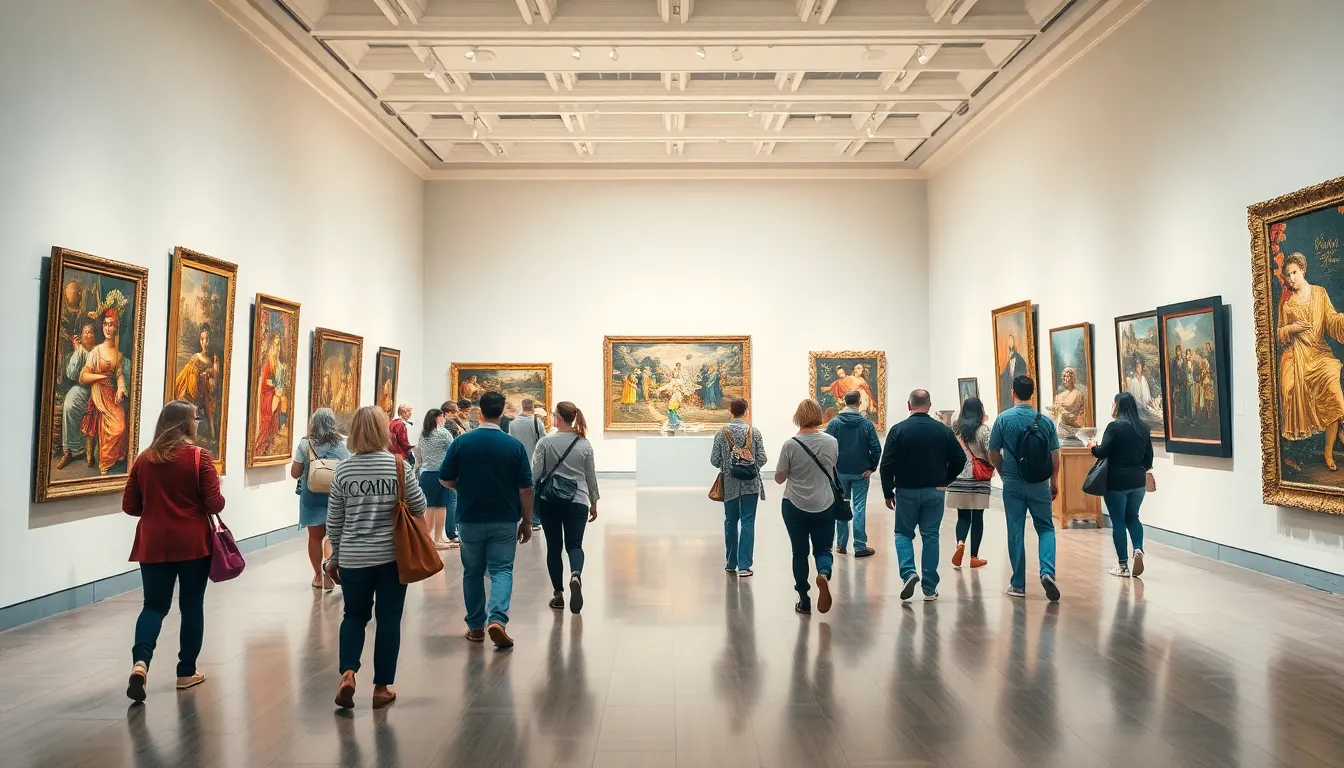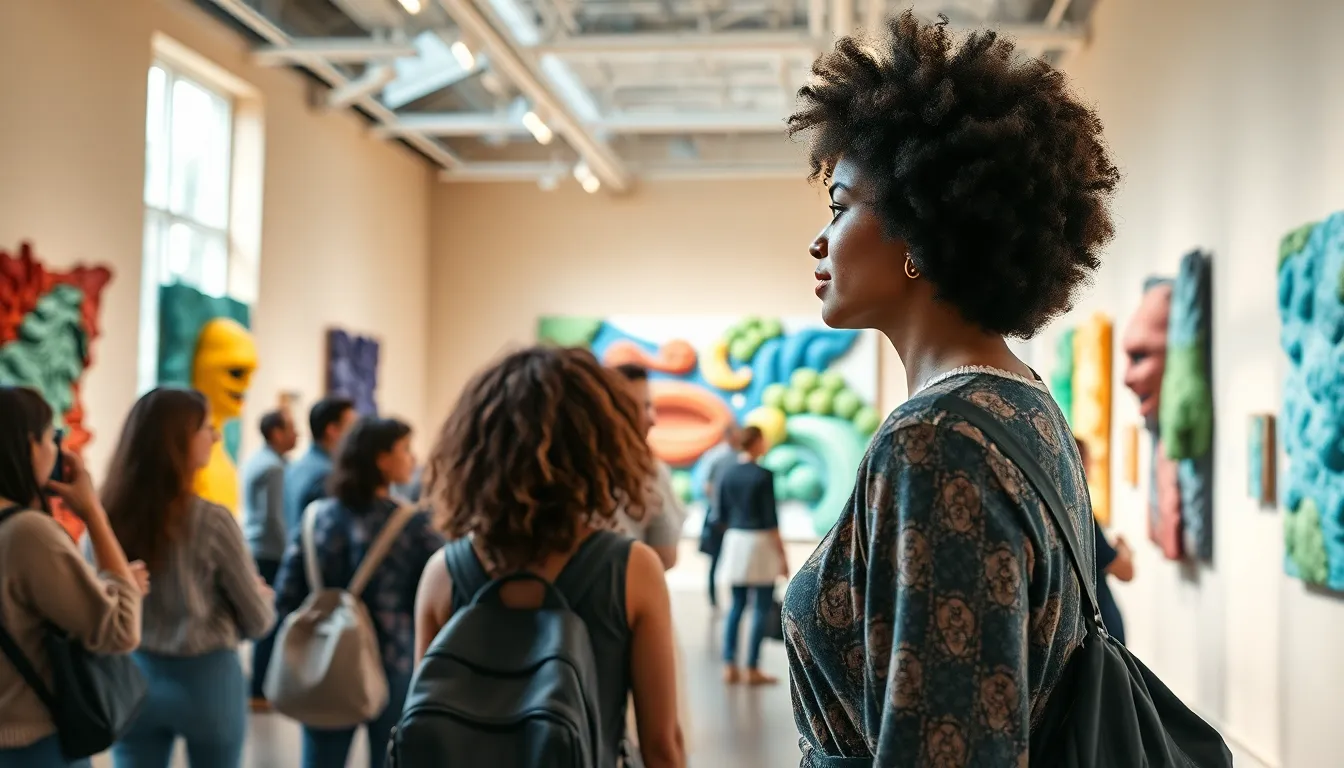Art museums are like treasure chests filled with gems that spark imagination and stir emotions. They invite visitors to step into a world where creativity knows no bounds. Whether it’s a masterpiece that takes your breath away or a quirky installation that makes you chuckle, these institutions offer something for everyone.
Picture this: a rainy day, a cozy café, and a stroll through a gallery that transports you to another realm. Art museums don’t just showcase paintings; they tell stories that connect us to history, culture, and each other. So grab your beret and prepare to dive into a vibrant world of colors, shapes, and maybe even a little confusion. After all, who wouldn’t want to ponder the meaning of a giant banana taped to a wall? Let’s explore the wonders of art museums and discover why they deserve a spot on everyone’s bucket list.
Table of Contents
ToggleOverview of Art Museums
Art museums serve as vital cultural hubs showcasing artistic heritage. They house collections ranging from classical to contemporary art, allowing visitors to experience diverse styles and influences. These institutions often feature renowned works from globally acclaimed artists, making them significant sites for education and inspiration.
Visitors find exhibitions often change, providing fresh opportunities to engage with new art forms. Special events, workshops, and lectures frequently occur, enhancing the overall experience. Educational programs tailored to various age groups promote deeper understanding and appreciation of art.
Architecture plays a critical role in the museum experience. Structures designed for aesthetic appeal often enhance interactions with the artwork. Historic museums, such as the Louvre in Paris, reflect rich cultural narratives, while modern buildings, like the Guggenheim in New York, draw attention for their innovative designs.
Accessibility remains a priority for many art museums. Institutions strive to create inclusive environments for all visitors, featuring guided tours, audio descriptions, and available resources for individuals with disabilities. Many museums also implement free or discounted admission days, encouraging wider community engagement.
In addition to visual art, museums often showcase multimedia installations and performance art. This diversity of media broadens the scope of artistic expression. Collaborations with local artists further enrich the offerings, fostering connections between art and community.
Art museums not only provide aesthetic enjoyment but also stimulate dialogue about societal issues reflected in the artworks. They actively engage with contemporary topics, exploring themes such as identity, politics, and environmental concerns. Through this engagement, museums encourage visitors to reflect on their role in society.
Importance of Art Museums

Art museums hold immense importance in society as cultural touchstones and educational resources. These institutions foster a deeper understanding of art and history, impacting both personal and collective experiences.
Cultural Significance
Art museums play a vital role in preserving cultural heritage. They house significant artworks that encapsulate historical narratives and artistic movements. Such venues bridge connections between the past and present, allowing visitors to explore diverse artistic expressions. Additionally, art museums reflect societal values and provoke discussions on contemporary issues. They often engage with themes such as identity, community, and social challenges. By hosting exhibitions that highlight marginalized voices, these institutions promote inclusivity and cultural awareness. Every painting or sculpture adds depth to the community’s cultural fabric, making these spaces essential for enriching public life.
Educational Value
Education thrives within the walls of art museums. They provide exceptional programs that cater to a wide range of learners, from school groups to adult workshops. Guided tours and lectures offer insightful perspectives on artworks, enhancing understanding and appreciation. Furthermore, interactive exhibits enable hands-on learning experiences. Many museums collaborate with local schools, fostering creativity and enriching the curriculum. Visitors gain exposure to various art forms, media, and techniques. Art museums serve not only as exhibition spaces but also as classrooms that stimulate curiosity and critical thinking. Engaging with artworks encourages personal reflection, turning every visit into an opportunity for growth and learning.
Types of Art Museums
Art museums encompass various categories, each offering unique experiences and collections.
Fine Arts Museums
Fine arts museums primarily focus on traditional art forms. They showcase paintings, sculptures, and prints from various historical periods and cultures. Visitors often encounter renowned artists such as Vincent van Gogh and Claude Monet represented in their collections. Exhibitions frequently rotate, allowing audiences to appreciate both classic masterpieces and lesser-known gems. Educational programs further enrich the experience, with guided tours enhancing understanding of artistic techniques and historical context.
Contemporary Art Museums
Contemporary art museums highlight art produced in the present day. These institutions often feature dynamic works that challenge conventional forms and explore current societal issues. The experience includes multimedia installations, performances, and thought-provoking exhibitions that invite interaction. Artists such as Yayoi Kusama and Banksy are commonly represented, appealing to diverse tastes. Engaging events and discussions often accompany the exhibits, providing deeper insights into the evolving landscape of contemporary art.
Specialty Museums
Specialty museums focus on specific themes or types of art. They might cover photography, textiles, or folk art, providing targeted exploration of niche subjects. Unique collections enable visitors to delve deeper into the specified medium, showcasing both historical and contemporary pieces. These museums often serve as important educational resources, offering workshops and community programs that encourage creativity. By highlighting specific art forms, specialty museums enrich the understanding of individual artistic disciplines and their cultural significance.
Notable Art Museums Around the World
Art museums worldwide serve as vital cultural touchstones and centers of creativity, showcasing priceless collections that inspire and educate.
The Louvre
The Louvre in Paris stands as the largest art museum in the world. Home to iconic works like the Mona Lisa and the Venus de Milo, it attracts millions of visitors annually. Its vast collection spans over 9,000 years, encompassing ancient civilizations to modern art. Architecture marvels, such as the glass pyramid entrance, add a contemporary twist to its historic essence. With frequent exhibitions and educational programs, the Louvre deepens the visitor experience while connecting audiences to art’s rich history.
The Metropolitan Museum of Art
The Metropolitan Museum of Art in New York City ranks among the most influential art museums globally. Visitors experience over 2 million works, including masterpieces from around the world. The museum’s diverse collections range from ancient artifacts to contemporary pieces. Iconic exhibitions showcase renowned artists such as Rembrandt and Van Gogh. Furthermore, guided tours and family programs provide educational perspectives that enhance engagement with the art. The Met fosters an appreciation for cultural heritage through innovative initiatives and special events.
The Tate Modern
The Tate Modern in London features the largest collection of contemporary art in the UK. Housed in a former power station, it presents a unique industrial backdrop for innovative artworks. Artists like Picasso, Warhol, and Hockney represent the dynamic range of contemporary creativity displayed. Installations challenge conventional boundaries, sparking discussions on societal issues. Additionally, the museum frequently offers workshops and exhibitions, making it accessible to audiences of all ages. Visitors leave enriched, having engaged with thought-provoking art in an inspiring environment.
Art museums stand as vital pillars of culture and creativity. They invite exploration and reflection, offering a diverse range of experiences that resonate with visitors of all ages. Each visit presents an opportunity to connect with history and engage with contemporary issues through art.
By showcasing various forms of artistic expression, these institutions foster inclusivity and encourage dialogue. Whether it’s the grandeur of a classical masterpiece or the thought-provoking nature of contemporary installations, art museums enrich lives and stimulate minds.
In a world where creativity knows no bounds, art museums remain essential in preserving and celebrating the artistic heritage that shapes society. Embracing the vibrant experiences they offer can lead to personal growth and a deeper appreciation for the arts.



